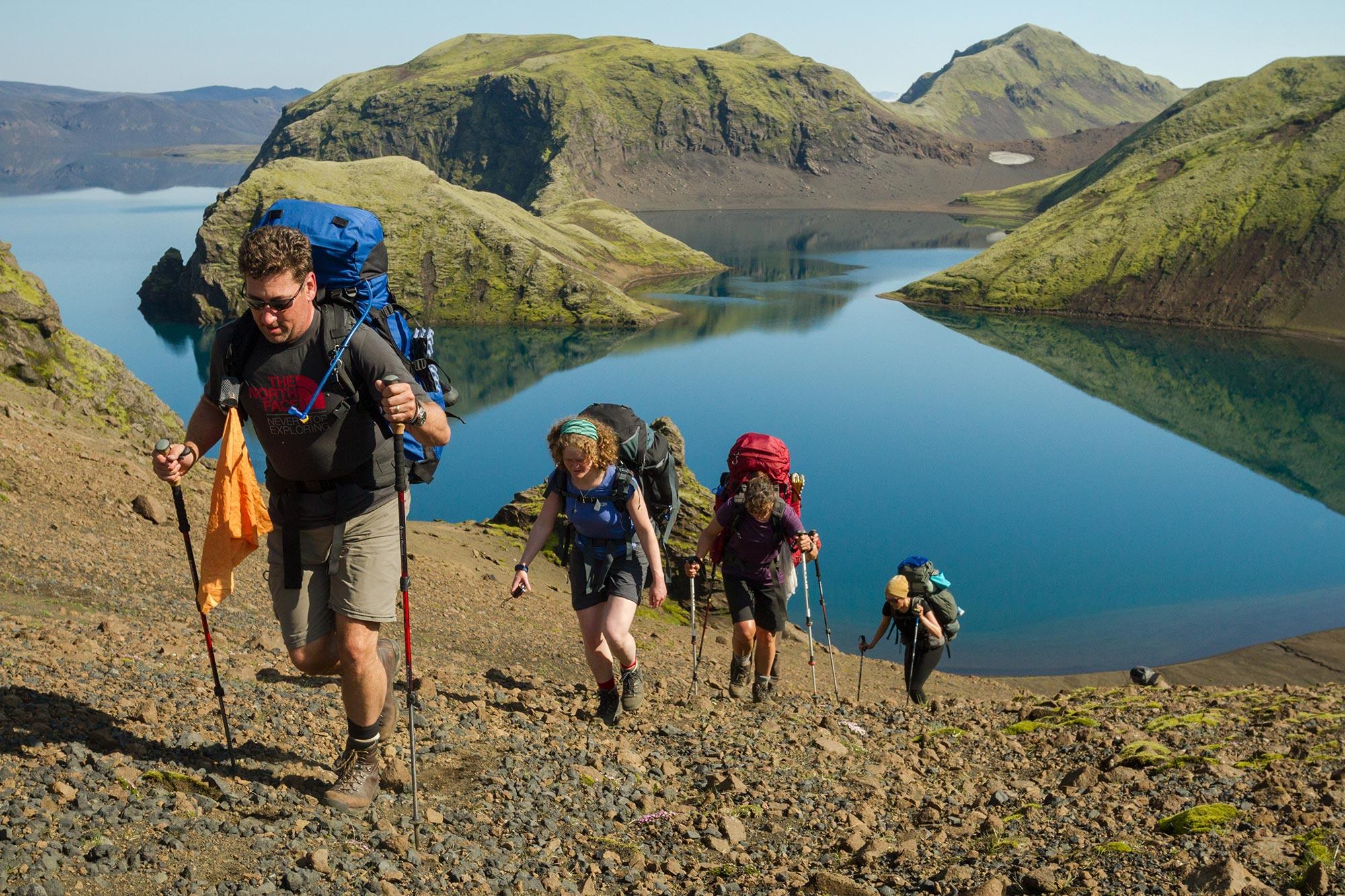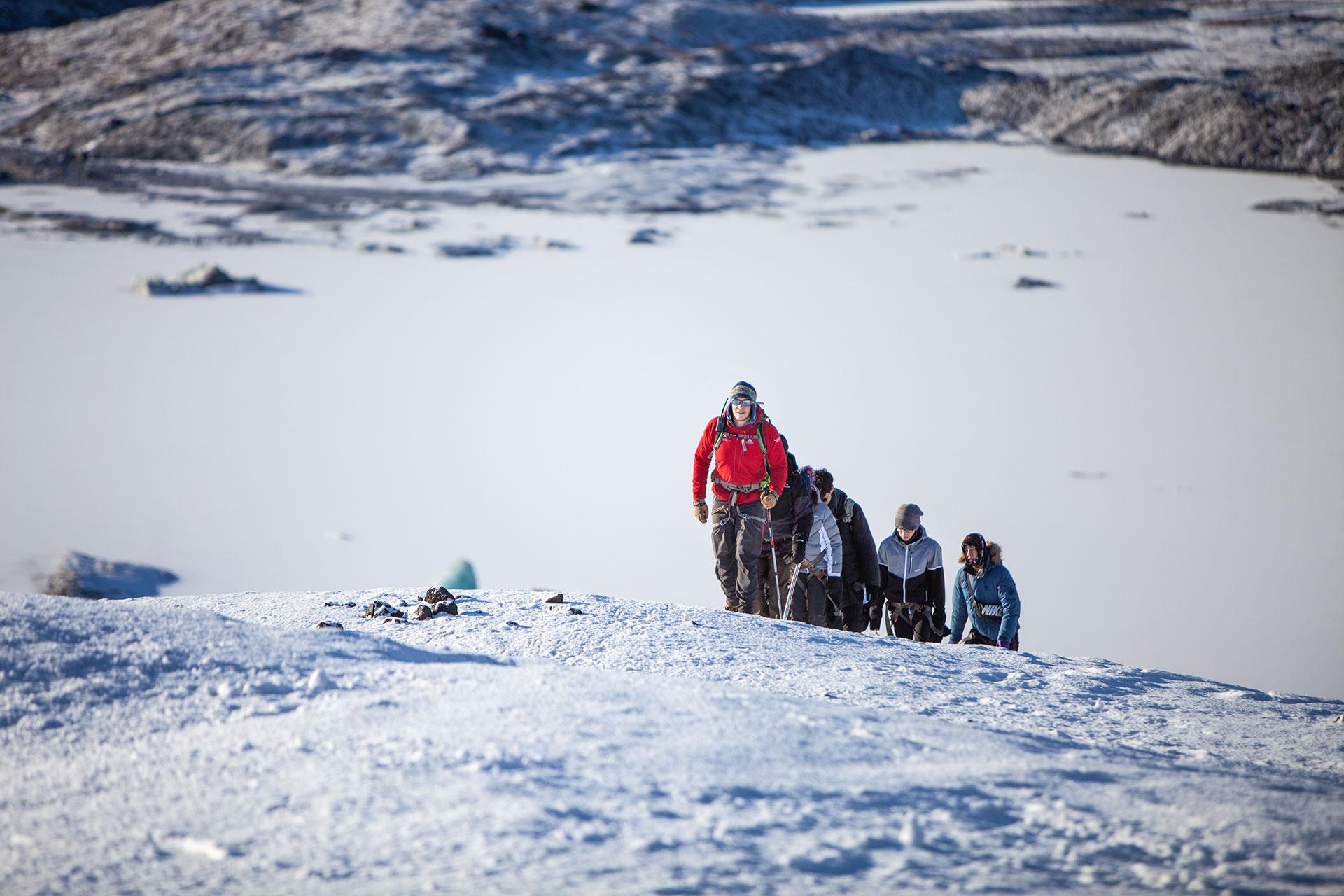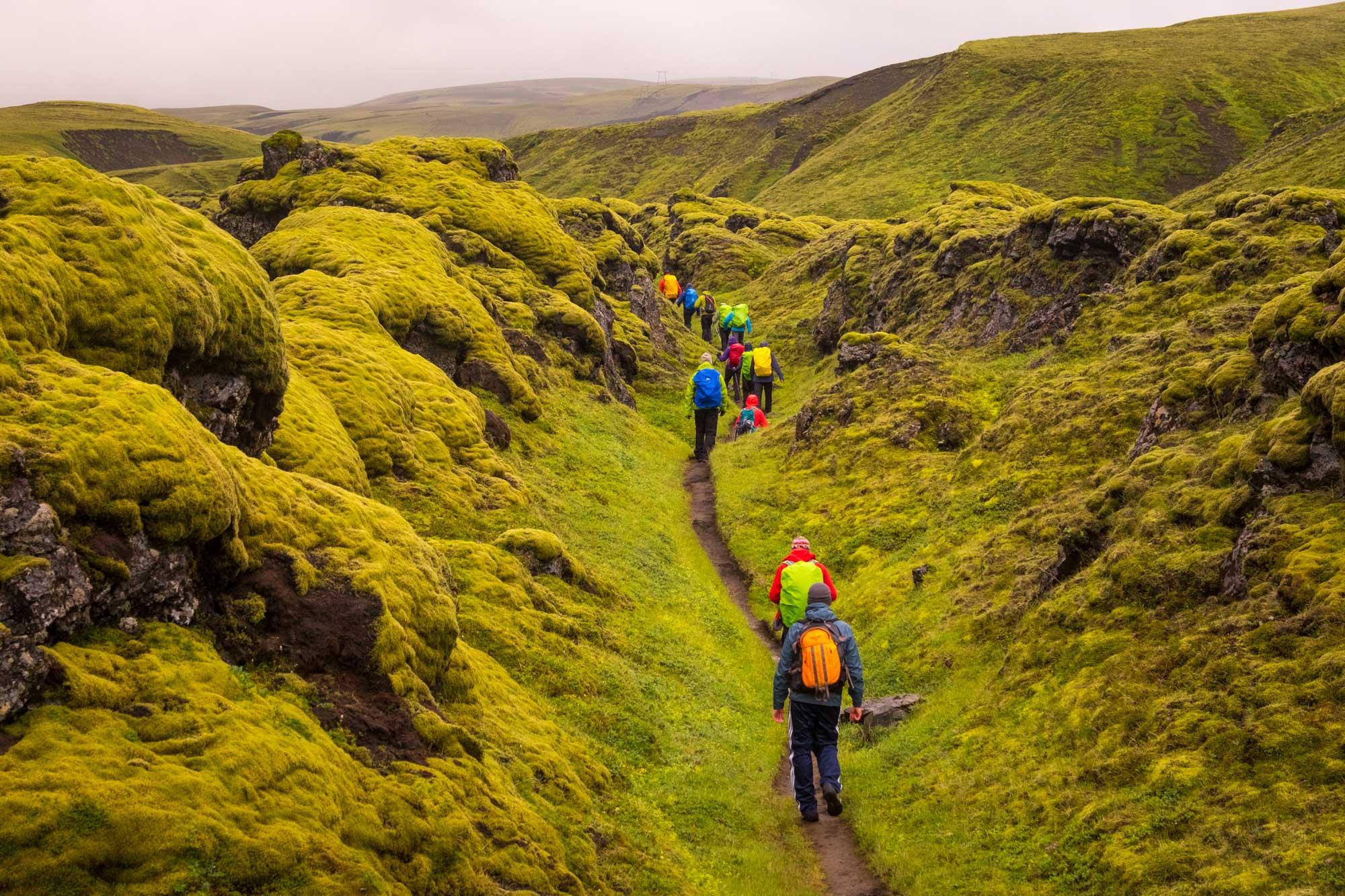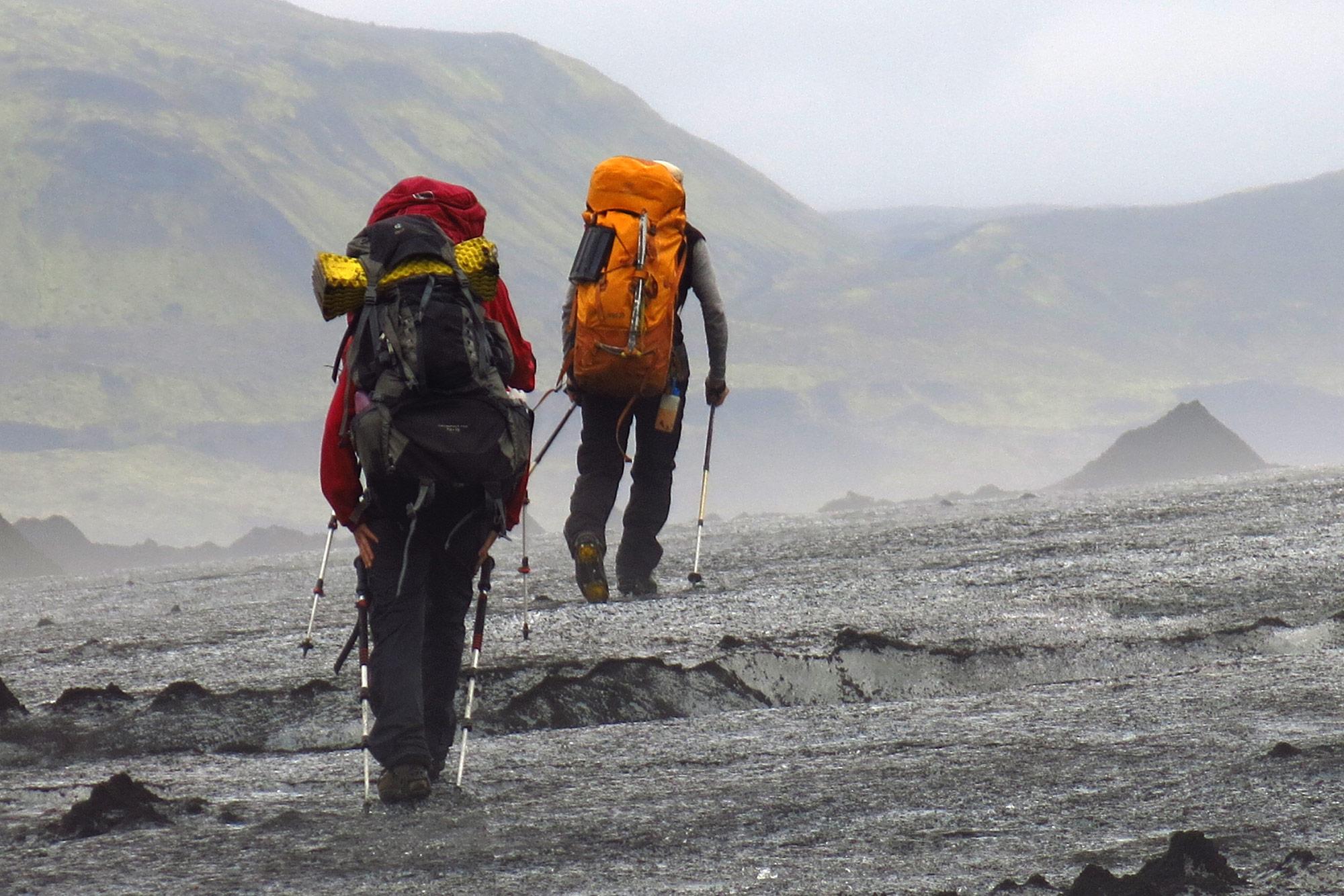The Ultimate Guide to Hiking in Iceland
| DISCOVER ICELAND, Travel Guide
Whether you’re an avid hiker or you consider yourself to be more hike-curious, there is no better place to hit the marked trail than Iceland. Hiking in Iceland is an experience not soon forgotten, providing exhilarating physical activity with vistas so stunning they’ll make you weak in the knees — luckily for those looking to cover some serious ground, that’s just a turn of phrase.
In this blog post we’ll walk you (no pun intended) through why you should take a hike in Iceland, what Icelandic hiking trails you should add to your bucket list, how to prepare for your hike in Iceland, and more.
We hope you’ve stretched, because your ultimate guide to hiking in Iceland starts now.

Why should you take a hike in Iceland?
Iceland is a beautiful country. It is often described as unique, ethereal, and other-worldly, and, while those terms can get a little repetitive, they’re still absolutely spot on. Icelandic nature — and by extension, Iceland’s numerous hiking trails — are unique, ethereal and other-worldly. We’d also add on challenging, exhilarating and rewarding.

Beautiful Nature
So, with all those adjectives front of mind, one major reason to go hiking in Iceland is to get up close and personal with its uniquely stunning and varied landscape. You can get a glimpse of its beauty while driving the Ring Road or touring the Golden Circle, but venturing out on a hiking trail will really immerse you in nature. Hitting the trail is the best way to truly experience all Iceland has to offer.
And variety is the key word here, with what you see and experience depending on the hiking trail you follow.
The Landmannalaugar geothermal area stuns with its rainbow rhyolite peaks. These colourful rhyolite mountains are the product of an eruption of silica-rich lava that cooled quickly at the surface. Þórsmörk on the other end of the Laugavegur Trail is a verdant oasis of birch trees.
Then there’s the highland desert, the craggy lava rock formations, the mountain canyons, the lush mossy valleys and waterfalls seemingly in every direction you look.
There’s just no comparing exploring and experiencing these natural phenomena up close rather than through your car window.

Disappearing Landscapes
A glacier hike, meanwhile, is a once-in-a-lifetime (for most people, at least) chance to tread across the surface of one of the world’s ice caps. With climate change threatening Iceland’s glaciers and other ice caps around the world, it’s a humbling experience to see these ice formation up close, and experiencing them as the wonders that they are, with their deep crevasses and aquamarine pools.
Hiking on a glacier’s surface is vastly different from trekking along a rocky ridge, so it’s a thrill for even more experienced hikers.

Something for everyone
Another reason to take a hike in Iceland is the variety of trails. There really is something for everyone. Inexperienced hikers can meander the walking paths around Reykjavík, take a short hike to the Reykjadalur hot spring, or try a short guided glacier walk. Expert hikers can conquer Iceland’s famed three peaks, embark on a five-day Laugavegur Trek or even push themselves to a conquer a multi-week trek across the entire country.
Even better, there are countless train options for every experience level in between those two extremes.
The best hikes to take while in Iceland
We’ve said it before and we’ll say it again: Iceland is a hiker’s paradise. There are hiking trails of every length and elevation and suitable for nearly every fitness level. Here are Icelandic Mountain Guides’ favourite hiking trails in Iceland.

1. Laugavegurinn
There’s a reason the Laugavegur trail is the most popular hiking trail in Iceland. It’s a rewarding hike that offers a whirlwind of scenery, from the colourful rhyolite mountains of Landmannalaugar, through black volcanic rock, emerald green moss, and into the lush Þórsmörk Valley. This is the bucket-list trek that every hiker in Iceland needs to complete.
- Total Distance: 56 km
- Max Ascent: 600 m
- Duration: 5 days
- Suggested Hike: Laugavegur Trek Classic (Huts) or Laugavegur Trail Self Guided

2. Fimmvörðuháls
The hiking trail over Fimmvörðuháls is so spectacular that it has been named one of the best hikes in the world by National Geographic. The 10-hour hike leads to an elevation of 1000 m, cutting between Mýrdalsjökull and Eyjafjallajökull glaciers, by the mighty Magni and Móði craters formed by Eyjafjallajökull’s eruption in 2010. From there, the trail descends into Þórsmörk valley, providing sweeping views of Iceland’s rugged Highlands and a landscape of jagged black peaks and lush emerald green vegetation. It is a truly stunning area to experience. What’s more, it can be combined with a five-day Laugavegur trek for an epic six-day adventure.
- Total Distance: 22 km (Fimmvörðuháls day hike)
- Max Ascent: 1000 m
- Duration: 10 hours
- Suggested Hikes: Day Hike over Fimmvörðuháls or 6-Day Laugavegur and Fimmvörðuháls Premium Trek

3. Víknaslóðir
The Víknaslóðir Trail in remote East Iceland takes hikers through a magnificent landscape of jagged, colourful mountains and oceanic bays. The trail, from beautiful Borgarfjörður to the colourful eastern village of Seyðisfjörður, snakes along the edges of fjords and through green valleys, where the only other signs of life you'll likely encounter are grazing sheep. The combination of mountain and ocean views makes this trek a unique experience.
- Total Distance: 75 km
- Max Ascent: 600 m
- Duration: 5 days
- Suggested Hikes: Víknaslóðir Trail or In the Shadow of Vatnajökull

4. Volcanic Trails
While the Laugavegur Trail gets all the glory, the Volcanic Trail deserves its fair share of the love. It has all the beauty of the Laugavegur Trail — think rhyolite mountains, black rock, lush moss — with the bonus feature of being far less populated by other hikers. This remote trail takes you through one of Iceland's most spectacular volcanic regions and is the perfect trek for those looking to venture off the beaten track. The trek takes hikers into the wilderness of Vatnajökull National Park, over Sveinstindur mountain (delivering a fantastic view of lake Langisjór), and along the Skaftá river through bright green moss-covered lava formations, impressive waterfalls, canyons, and amazing craters, to the Eldgjá volcanic fissure and through the black sands and green moss of Mælifellssandur desert.
- Total Distance: 130 km
- Max Ascent: 450 m
- Duration: 9 days
- Suggested Hikes: Volcanic Trails

5. Glacier Panorama Trail
This hike gives you a glance into the world of geological wonders in Iceland and how glaciers have shaped the land for thousands of years. Plus, it rewards hikers with sweeping views of Iceland's famed black beaches and Eyjafjallajökull volcano while trekking alongside and over Sólheimajökull glaciers and being immersed in the tranquility of a remote hidden gem of a trail.
- Total Distance: 13.7 KM
- Max Ascent: 750 m
- Duration: 6 hours
- Suggested Hikes: Glacier Panorama Trail
When is the best time to hike in Iceland?
Icelandic nature is beautiful in all seasons and many hikes — glacier hikes, for example — are well suited for the colder winter months. But the ideal time to hike in Iceland is in the summer.
The months of June, July and August boast long days and the best forecasts. Summer in Iceland may not deliver the heat some visitors are used to. The average summer temperature rarely surpasses 20º C, and, as throughout the year, the weather can be unpredictable. Still, the extremes won’t be as severe during the summer months, so hikes and tours are far less likely to be cancelled or postponed due to weather.
Another very big perk of hiking in the Icelandic summer is the midnight sun. There’s something so freeing about hiking out in nature knowing that you can explore longer and trek further, safe in the knowledge that there will still be enough daylight to set up camp when you are ready to call it a night. The long summer days are truly magical… just be sure to pack a sleeping mask.
If you are visiting Iceland during the winter and fancy a hike, don’t despair, you’re not without options. We’ve already mentioned taking a guided glacier hike during the winter months, but there’s also the possibility of embracing the long, dark nights and combining an active adventure with northern lights spotting. Whether you’re braving one cold Icelandic night to spot the auroras or a four-day winter walkabout is more your speed, hiking in Iceland during the winter won’t disappoint.

How to prepare for a hike in Iceland
Just as you would do when getting dressed for any other day, you should consider the weather conditions when planning what to pack for your hike and how to dress. The only difference is that you will have to consider the weather conditions at the elevation you’ll be ascending to, as well. The weather may be mild in Reykjavík, but rather cold atop the plateau you will be traversing on foot that day.
Another consideration is the trail conditions. While many of Iceland’s more well trod hiking trails are well maintained, some stretches can be particularly rocky or uneven and they can be slippery, icy, muddy or snowy, depending on the season and how the weather conditions have been.
A good thing to remember when dressing for a hike is that layers are your friend. You can always take a layer off if you’re too warm, but you’ll just be left cold, wet, miserable and in potential trouble if you don’t have enough (and appropriate) layers to begin with.
Here is what we would recommend wearing for any hike:
Base layer
Start with a base layer of clothing made from wool, silk or polyester. The base layer is meant to wick moisture away from your skin and provide light, quick-drying insulation. Don’t wear a cotton base layer — it will absorb your sweat and make you colder.
Mid layer
Add a layer to provide insulation and retain your body heat, while remaining breathable. The best materials for this layer are wool, fleece or goose down.
Outer shell
Top it off with an outer layer that will protect the other layers — and you — from the rain, wind and snow. This layer should be lightweight and quick-drying, like Gore-Tex or eVent.
Footwear
Choose appropriate footwear for your hike and the weather conditions, including wool or synthetic socks, and sturdy hiking boots or hiking shoes.

Getting those crampons on!
Being prepared for your hike in Iceland involves more than simply getting dressed in the right clothing. Once you’ve carefully considered where you’re hiking and the conditions you’ll be facing, you’ll want to ensure you have the correct gear and provisions to make the hike a happy one.
Here are some items you should pack in your backpack:
First aid kit
At the very least, your first air kit should include bandages and blister pads, but it would also be wise to have disinfectant wipes, hand sanitiser, painkillers (like ibuprofen or paracetamol), a Swiss-army knife, and even duct tape.
Water
You’ll need around 1 litre of water for a two-hour hike. There will often be water sources along the trails of longer hikes, but you’ll need to start with a decent amount of water so you’re not getting dehydrated before you reach them.
Snacks & Food
Consider packing trail mix or granola bars for shorter hikes, and energy gel for more strenuous treks. If you’re going on a multi-day trek, carefully what you’ll eat for each meal and snacks so you don’t find yourself with a grumbling stomach or with depleted energy at the half-way point.
Sun protection
Iceland isn’t a tropical destination, but it’s still very easy to get sunburnt. Protect your eyes and skin with sunglasses and a high SPF sunscreen.
Map & Compass
Google Maps is all fun and games until you hit connectivity issues. A good old fashioned map will get you from point A to B with reliability. Study it in advance to know where you’re going and make sure you know how to use your compass.
A phone or a Personal Location Beacon
If you find yourself in trouble on the trail, you’ll want a way to call for help. PLBs can be rented from SafeTravel.is.
The number one thing you should do before embarking on any self-guided hike or trek in Iceland is to let people know where you’re going and when you’ll be back. You can register travel plans with SafeTravel.is and check in with them for weather alerts and travel conditions.
What else to be prepared for while hiking in Iceland
Weather
The weather is a major factor you should be prepared for when hiking or trekking in Iceland. You should absolutely check the forecast each day, but be prepared for the weather to change, sometimes rapidly and dramatically.
The best way to be prepared for the weather is to dress in appropriate layers for your hike. Another way to be prepared is to listen to the locals and don't underestimate how bad the weather can get.
If bad weather does set in and visibility is low, your safest bet it to simply sit down stay put while it passes by.
Fatigue
Part of preparing for a hike is taking stock of your own physical fitness level and abilities. A hike in one of Iceland’s national parks is not a literal “walk in the park.” Depending on the trail you plan on hiking, the trek can be physically demanding. Don’t over-commit.

Why book a guided hike in Iceland?
There are many benefits to taking a guided hike while in Iceland. The terrain, scenery and weather conditions will be the same whether you embark on a guided or self-guided hike, but a guide will structure the hike, ensuring that the group is walking at a pace that is suitable for everyone, while sharing educational information about the area in which you’re hiking. You won’t just see the sites, you’ll know all about them.
Moreover, a guide will be there to answer any questions that arise on the trail and look out for your safety. Icelandic Mountain Guides’ guides are all experts on the trails they’re taking groups along and first aid certified. They know the trails forward and backward and are prepared for any conditions that might arise. Plus, they’re great company and can whip up a hearty breakfast.
Then there’s the camaraderie. On a guided hike, you’ll be experiencing the trail with other likeminded people from around the world. It’s a unique experience to meet new people and make new friends.
Taking a self-guided hike is a fine plan for those who prefer to maybe sleep a little longer, go at their own pace and do everything for themselves along the trail. If you book a self-guided hike or trek with Icelandic Mountain guides, you’ll be given a map and a detailed description of the trail so you’ll be off to a strong start.

Should you book in advance?
Yes! We highly recommend booking your guided or self-guided hikes in advance. Guided hikes along Iceland’s more popular hiking trails, like the Laugavegur Trail, can fill up weeks in advance, and even shorter day tours and hikes can be fully booked.
If the hike or tour you're interested in is fully booked, be in touch and Icelandic Mountain Guides can suggest other options that will tick all your boxes.
Don’t want to miss out on the adventure of your dreams; secure your spot on the tour of your choice ahead of time on mountainguides.is.
Keep me informed about the Icelandic Mountain Guides Blog
Outdoor adventure in Iceland is our specialty. Subscribe to our free monthly newsletter to learn when to go, what to do and where to have the best adventures in Iceland.
Related Blog Posts
Related Tours

Laugavegur Trek Classic (Huts)

Volcanic Trails



